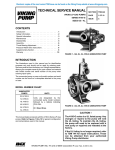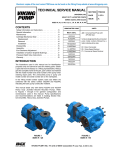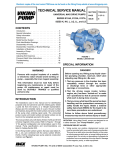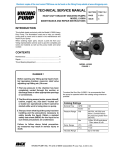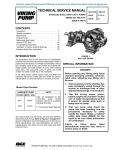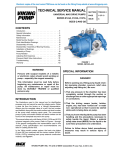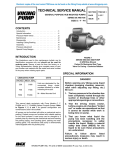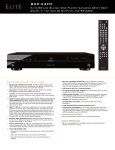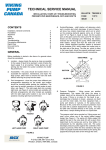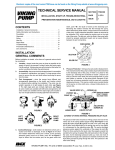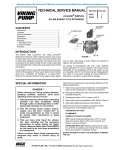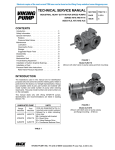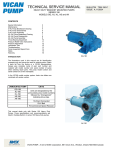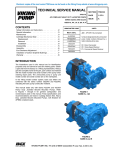Download TECHNICAL SERVICE MANUAL SECTION TSM 1470
Transcript
Electronic copies of the most current TSM issue can be found on the Viking Pump website at www.vikingpump.com TECHNICAL SERVICE MANUAL INSTALLATION, START UP, TROUBLESHOOTING, pREVENTIVE MAINTENANCE, DO’S & DON’TS SECTION TSM 1470 PAGE 1 of 8 ISSUE F GP-04, GP-05 & GP-07 HI-LO DOUBLE PUMPS CONTENTS Introduction . . . . . . . . . . . . . . . . . . . . . . . .1 Repair . . . . . . . . . . . . . . . . . . . . . . . . . . 1 Safety Information . . . . . . . . . . . . . . . . . . . . 2 Installation . . . . . . . . . . . . . . . . . . . . . . . . 3 Start Up . . . . . . . . . . . . . . . . . . . . . . . . . 4 Troubleshooting . . . . . . . . . . . . . . . . . . . . . 4 Miscellaneous . . . . . . . . . . . . . . . . . . . . . . 5 Do’s and Don’ts . . . . . . . . . . . . . . . . . . . . . 6 INTRODUCTION General figure 2 GP-05 Hi-Lo Double Pump The following items must be considered prior to pump installation: 1. Location - locate the pump as close as possible to the supply of the liquid being pumped. If possible, locate the pump below the liquid supply. Viking pumps are self priming; but, the better the suction conditions, the better the pump will perform. 2. Accessibility - the pump must be accessible for inspection, maintenance and repair. 3. Suction/Discharge - Hi-Low Double pumps are designed for clockwise rotation only (viewed from shaft end). Refer to Figure 1. 4. Pump Life - pump life is a factor of many parameters, mainly pressure, speed and duty cycle. Temperature, contamination and type of hydraulic oil also have a definite effect. 5. Hydraulic Oil - Viking recommends using industrial grade hydraulic oil. Temperature must not exceed 150 ºF for optimum life of hydraulic oil. Operating viscosity must be between 100 and 300 SSU. 6. Filter / Strainer - on a hydraulic system, use a return line filter with a maximum 10 micron rating to keep the system clean and free of contaminating elements. A 100 mesh strainer is recommended in the suction line. REPAIR 1. Parts For A Preventative Maintenance Program - Mechanical Seal or Lipseal(s) (Not applicable for Mag Drive pumps) -O-rings 2. Parts For A Major Overhaul - The Viking Spur Gear series pumps have very tight clearances and precision machining tolerances, and wear on any of the parts will typically indicate that most of the critical parts are worn. Therefore, if wear is found on any of the pump parts, Viking recommends replacing the entire pump. Always supply the serial number from your pump nameplate when requesting a replacement. S D S D 7. Pressure Relief Valve - a pressure relief device must be installed in the system to provide over-pressure protection. If a line is blocked or closed, pressure builds up until the motor stalls, drive equipment fails, a pump part breaks or piping bursts. 8. Discharge Line - select discharge piping, hoses and fittings rated for maximum system pressure. 9.Storage - if the pump is to be stored, drain the pump and apply a light coat of non-detergent SAE 30 weight oil to all internal pump parts. Apply grease to the pump shaft extension. Viking suggests rotating the pump shaft by hand one complete revolution every 30 days to circulate the oil. figure 1 VIKING PUMP, INC. • A Unit of IDEX Corporation • Cedar Falls, IA 50613 USA SAFETY INFORMATION AND INSTRUCTIONS IMPROPER INSTALLATION, OPERATION OR MAINTENANCE OF PUMP MAY CAUSE SERIOUS INJURY OR DEATH AND/OR RESULT IN DAMAGE TO PUMP AND/OR OTHER EQUIPMENT. VIKING’S WARRANTY DOES NOT COVER FAILURE DUE TO IMPROPER INSTALLATION, OPERATION OR MAINTENANCE. THIS INFORMATION MUST BE FULLY READ BEFORE BEGINNING INSTALLATION, OPERATION OR MAINTENANCE OF PUMP AND MUST BE KEPT WITH PUMP. PUMP MUST BE INSTALLED, OPERATED AND MAINTAINED ONLY BY SUITABLY TRAINED AND QUALIFIED PERSONS. THE FOLLOWING SAFETY INSTRUCTIONS MUST BE FOLLOWED AND ADHERED TO AT ALL TIMES. Symbol Legend : ! ! Danger - Failure to follow the indicated instruction may result in serious injury or death. BEFORE opening any liquid chamber (pumping chamber, reservoir, relief valve adjusting cap fitting, etc.) be sure that : ● Any pressure in the chamber has been completely vented through the suction or discharge lines or other appropriate openings or connections. ● The pump drive system means (motor, turbine, engine, etc.) has been “locked out” or otherwise been made non-operational so that it cannot be started while work is being done on the pump. WARNING WARNING ! WARNING ● You know what material the pump has been handling, have obtained a material safety data sheet (MSDS) for the material, and understand and follow all precautions appropriate for the safe handling of the material. ! ! ! ! WARNING ! WARNING BEFORE operating the pump, be sure all drive guards are in place. DO NOT operate pump if the suction or discharge piping is not connected. ! ! DO NOT place fingers into the pumping chamber or its connection ports or into any part of the drive train if there is any possibility of the pump shafts being rotated. DO NOT exceed the pumps rated pressure, speed, and temperature, or change the system/duty parameters from those the pump was originally supplied, without confirming its suitability for the new service. ! WARNING BEFORE operating the pump, be sure that: ● It is clean and free from debris ● all valves in the suction and discharge pipelines are fully opened. ● All piping connected to the pump is fully supported and correctly aligned with the pump. ● Pump rotation is correct for the desired direction of flow. ! WARNING SECTION TSM 1470 ISSUE F PAGE 2 OF 8 Warning - In addition to possible serious injury or death, failure to follow the indicated instruction may cause damage to pump and/or other equipment. INSTALL pressure gauges/sensors next to the pump suction and discharge connections to monitor pressures. USE extreme caution when lifting the pump. Suitable lifting devices should be used when appropriate. Lifting eyes installed on the pump must be used only to lift the pump, not the pump with drive and/or base plate. If the pump is mounted on a base plate, the base plate must be used for all lifting purposes. If slings are used for lifting, they must be safely and securely attached. For weight of the pump alone (which does not include the drive and/or base plate) refer to the Viking Pump product catalog. DO NOT attempt to dismantle a pressure relief valve that has not had the spring pressure relieved or is mounted on a pump that is operating. AVOID contact with hot areas of the pump and/or drive. Certain operating conditions, temperature control devices (jackets, heat-tracing, etc.), improper installation, improper operation, and improper maintenance can all cause high temperatures on the pump and/or drive. THE PUMP must be provided with pressure protection. This may be provided through a relief valve mounted directly on the pump, an in-line pressure relief valve, a torque limiting device, or a rupture disk. If pump rotation may be reversed during operation, pressure protection must be provided on both sides of pump. Relief valve adjusting screw caps must always point towards suction side of the pump. If pump rotation is reversed, position of the relief valve must be changed. Pressure relief valves cannot be used to control pump flow or regulate discharge pressure. For additional information, refer to Viking Pump’s Technical Service Manual TSM 000 and Engineering Service Bulletin ESB-31. THE PUMP must be installed in a matter that allows safe access for routine maintenance and for inspection during operation to check for leakage and monitor pump operation. INSTALLATION Mounting Piping/Hose 1. Surfaces to which the pump mounts against must be clean and flat. The cause of many pumping problems can be traced to the suction piping. It should always be as large in diameter and as short in length as possible. 2. Use SAE Grade 5 or better capscrews to mount the pump. 3. The 4 mounting capscrews for GP-04 and GP-05 pumps must have a minimum of ½ inch engagement and must be torqued evenly to 12-15 ft.-lbs. 4. The 2 mounting capscrews for the SG-07 pumps must have a minimum of ½ inch thread engagement and must be torqued evenly to 50-55 ft.-lbs. 5. Do not strike or press the pump drive coupling half to install on the pump shaft. Damage to the pump or coupling may result. If the coupling does not slide onto the pump shaft, inspect the coupling bore, shaft and key for nicks or burrs and remove if present. 6. Once the pump has been mounted, place a small amount of compatible liquid into the suction port and turn by hand to ensure the pump turns freely. Alignment Check alignment after mounting. If the unit has a flexible coupling, remove any coupling guards or covers and check alignment of coupling halves. A straight edge (a piece of key stock will work) across the coupling must rest evenly on both rims at the top, bottom and sides. See Figure 3. USE STRAIGHT EDGE. THESE SURFACES MUST BE PARALLEL. Before starting the layout and installation of your piping system, consider the following points: 1. Never use piping smaller than the pump port connections. Piping larger in diameter than the port connection is sometimes required to reduce friction losses. 2. Be sure the inside of the pipe is clean before installing. 3. Do not use galvanized piping. 4. When approaching an obstacle in the suction line, go around instead of over it. Going over an obstacle may create an air pocket. Where practical, slope the piping so no air or liquid pockets will be formed. Air pockets in the suction line make it hard for the pump to prime. 5. Viking recommends using a strainer on the suction side of the pump. The strainer will keep foreign objects from going into the pump. A 100 mesh strainer is recommended. Provisions must be made for cleaning the strainer. Use of a strainer is particularly important at start up to help clean the system of weld beads, pipe scale and other foreign objects. 6. On a hydraulic system, it is recommended that a return line filter be installed having a maximum 10 micron rating. 7. A pressure relief valve is required in the discharge line. See Pressure Relief Valves, General page 1 item 7. 8. The pump must not be used to support piping. Weight of the pipe must be carried by hangers, supports, stands, etc. CHECK WIDTH BETWEEN THESE SURFACES WITH INSIDE CALLIPERS OR FEELER GAUGE TO BE CERTAIN THE FACES ARE EQUAL DISTANCE APART AND PARALLEL. figure 3 Danger ! Before starting pump, be sure all drive equipment guards are in place. Failure to properly mount guards may result in serious injury or death. 9. When fastening to the pump do not impose any strain on the pump casing. “Springing” or “drawing” piping up to the pump will cause distortion, possible misalignment and probable rapid wear of the pump. Do not use the pump to correct errors in the piping layout or assembly. 10. All joints of piping system must be tight; liquid thread sealant will help assure leak free threaded joints. Loose joints result in liquid leaks or suction side leaks. Air leaks make the pump noisy and reduce flow. CAUTION: Be careful not to over tighten fittings as this can cause cracked joints. Do not use PTFE / plumber’s tape. Reduced friction makes over tightening very easy and will result in cracked ports. 11. Drive alignment must be checked after the piping is hooked up. SECTION TSM 1470 ISSUE F PAGE 3 OF 8 START UP TROUBLESHOOTING Before pushing the “start” button, check the following: A Viking pump that is properly installed and maintained will give long satisfactory performance. 1. Are vacuum and pressure gauges (liquid filled) mounted on or near the pump? Gauges are the quickest and most accurate way of finding out what is happening in the pump. 2. The pump is correctly aligned. 3. There is no pipe strain on the pump casing. 4. The pump shaft turns freely when rotated by hand. 5. The motor has been jogged and is running in the correct direction. Refer to “General” page 1 item 3. 6. A pressure relief valve is properly installed. 7. The suction piping is connected and tight, and the valves are open. 8. The discharge piping is connected and tight, valves are open and there is a place for the liquid to go. 9. All guards are in place. The “start” button can now be pushed. The pump must begin to deliver liquid within 15 seconds!! If not, push the “stop” button. Do not run pump without liquid flow longer than 30 seconds or the pump may be ruined!! Review the steps just outlined. Consider what the suction and discharge gauges indicate. If everything appears in order, re-prime the pump. Refer to Mounting, page 2, item 6. Push the “start” button. If nothing is flowing within 30 seconds, stop the pump. The pump is not a compressor; it will not build up much air pressure. It may be necessary to vent the discharge line until liquid begins to flow. If the pump still does not deliver liquid, consider one or more of the following: If trouble does develop, one of the first steps toward finding the difficulty is to install a vacuum gauge in the suction line and a pressure gauge in the discharge line. Readings on these gauges often give a clue on where to start looking for trouble. DANGER ! Before opening any Viking pump liquid chamber (pumping chamber, reservoir, relief valve adjusting cap fitting etc.) be sure: 1.That any pressure in chamber has been completely vented through the suction or discharge lines or other appropriate openings or connections. 2. That the driving means (motor, turbine, engine, etc.) has been “locked out” or made nonoperational so that it cannot be started while work is being done on the pump. 3. That you know what liquid the pump has been handling and the precautions necessary to safely handle the liquid. Obtain a material safety data sheet (MSDS) for the liquid to be sure these precautions are understood. Failure to follow the above listed precautionary measures may result in serious injury or death. 1. Air leak(s) in the suction line. 2. The end of the suction pipe is not submerged deep enough in to the liquid. 3. The suction lift is too great, the suction pipe is too small or the suction pipe run is too long. 4. Liquid is vaporizing in the suction line before it gets to the pump. If, after consideration of these points, the pump still does not deliver liquid, review all points given under START UP and read through the following TROUBLESHOOTING guide and try again. If the pump still will not deliver liquid, contact your Viking Pump supplier. Vacuum Gauge - Suction Port High vacuum reading would indicate: 1. The suction line is blocked or restricted, a valve is closed, the strainer is plugged. 2. The suction line is too small. 3. The liquid is too viscous to flow through the piping. 4. The lift required is too high. Low reading would indicate: 1. An air leak in the suction line. 2. The end of the pipe is not in the liquid. 3. The pump is worn. 4. The pump is dry and should be primed. Fluttery, jumping or erratic reading would indicate: 1. The liquid is vaporizing (cavitation). 2. Liquid is coming to the pump in slugs, a possible air leak or insufficient liquid above the end of the suction pipe. 3. Vibration from cavitation, misalignment, or damaged parts. SECTION TSM 1470 ISSUE F PAGE 4 OF 8 SPACER SECTION CHECK VALVE HIGH PRESSURE LOW VOLUME SECTION BRACKET SECTION SEQUENCE VALVE SPOOL ASSEMBLY SEQUENCE VALVE ADJUSTMENT ASSEMBLY HEAD SECTION LOW PRESSURE HIGH VOLUME figure 4 Viking Hi-Lo Pump Termiinology SECTION Pressure Gauge - Discharge Port MISCELLANEOUS High reading would indicate: Pump does not pump: 1. High viscosity and small diameter and/or lengthy discharge line. 1. The pump has lost its prime from an air leak or a low level in the tank. 2. The strainer or filter is plugged. 2. The suction lift is too high. 3. The pressure relief valve is set too high. 3. Rotating in the wrong direction. 4. Valve in the discharge line partially closed. 4. The motor does not come up to speed. 5. The line is partially plugged from product build up on the inside of the pump, solidified product or a foreign object. 5. The strainer is clogged. 6. Liquid in the pipe is not up to temperature. 7. The pump is worn out. Low reading would indicate: 1. Pressure relief valve is set too low. 2. Pressure relief valve poppet is not seating properly. 6. The bypass valve is open, the pressure relief valve set too low or the pressure relief valve poppet is stuck open. 8. Any changes in liquid, system or operation that would help explain the trouble, e.g. new liquid, additional lines or process changes. 3. Pump mounting capscrews are not torqued to specifications (GP-04 and GP-05 Series 12-15 ft.-lbs.). Pump starts, than loses its prime: 4. Pump assembly bolts are not torqued into specifications (GP-07 Series 50-55 ft.-lbs.). 2. The liquid is vaporizing in the suction line. 5. The pump check valve is stuck open or not seating properly. See figure 4. 4. The pump is worn out. 6. The pump is damaged or worn. Fluttery, jumping or erratic reading would indicate: 1.Cavitation. 2. Liquid is coming to the pump in slugs. 3. An air leak in the suction line. 4. Vibrating from misalignment or mechanical problems. 1. The supply tank is empty. 3. There is an air leak or air pockets in the suction line. Pump is noisy: 1. The pump is cavitating (liquid vaporizing in the suction line) or being starved (heavy liquid cannot get to pump fast enough). Increase the suction pipe size and/or reduce the length, or decrease the pump speed. If the pump is above the liquid, raise the liquid level closer to the center line of the inlet port. If the liquid is above the pump, increase the head of the liquid. 2. Check alignment. 3. Anchor the base or piping to eliminate vibration. SECTION TSM 1470 ISSUE F PAGE 5 OF 8 Pump is not delivering up to capacity: 1. The pump is starving or cavitating – see Pump is noisy, item 1. 2. The strainer is partially clogged. DO’S AND DON’TS Do’s and Don’ts for installation, operation and maintenance of Viking pumps to assure safe, long, trouble-free operation. 3. There is an air leak somewhere in the suction line. Installation: 4. Running too slow. Is the motor wired correctly and at the appropriate speed? 1. DO install the pump as close to the supply tank as possible. 5. Pressure relief valve is set too low, stuck open or has a damaged poppet seat. 2. DO leave working space around the pumping unit. 6. The bypass line around the pump is partially opened. 4.DO install a strainer in the suction line. 7. The pump is worn out. Pump takes too much power (stalls the motor): 1. The pump sequence valve set too high. 2. Liquid is more viscous than the unit is sized to handle. 3. The system pressure relief valve is set too high. 4. The pump is misaligned. 3. DO use large, short and straight suction port. 5. DO a double check of alignment after the unit is mounted and the piping is hooked up. 6. DO provide a pressure relief valve for the discharge side of the pump. 7.DO check for proper rotation. 8. DO use a return line filter. 9. DO use an industrial grade hydraulic oil. 10. DO use piping, hose and fittings rated for maximum system pressure. Operation 1. DON’T run the pump at speeds faster than 3600 RPM. 2. DON’T allow the pump to develop pressure higher than those shown in the Viking product catalog at that size. 3. DON’T operate pumps at temperatures above or below limits shown in the Viking product catalog for the model. 4. DON’T operate the unit without all guards in place. 5. DON’T operate the pump without a pressure relief valve in the discharge piping; be sure the valve is mounted and set correctly. 6. DON’T stick fingers in ports of the pump!!! Fingers may be pinched between the gears. 7.DON’T work on the pump unless the driver has been “locked out” so it cannot be started while work is being done on the pump. Maintenance: 1. DO record the pump model number and serial number and file for further use. 2. DO have spare parts, pump or stand-by units available; particularly if the pump is an essential part of the key operation process. 3. DO obtain, read and keep all maintenance instructions furnished with pump. SECTION TSM 1470 ISSUE F PAGE 6 OF 8 SECTION TSM 1470 ISSUE F PAGE 7 OF 8 TECHNICAL SERVICE MANUAL INSTALLATION, START UP, TROUBLESHOOTING, pREVENTIVE MAINTENANCE, DO’S & DON’TS SECTION TSM 1470 PAGE 8 of 8 ISSUE F GP-04, GP-05 & GP-07 HI-LO DOUBLE PUMPS WARRANTY Viking warrants all products manufactured by it to be free from defects in workmanship or material for a period of one (1) year from date of startup, provided that in no event shall this warranty extend more than eighteen (18) months from the date of shipment from Viking. The warranty period for Universal Seal series pumps ONLY (Universal Seal models listed below) is three (3) years from date of startup, provided that in no event shall this warranty extend more than forty-two (42) months from the date of shipment from Viking. UNDER NO CIRCUMSTANCES SHALL VIKING BE LIABLE UNDER THIS WARRANTY OR OTHERWISE FOR SPECIAL, INCIDENTAL, INDIRECT, CONSEQUENTIAL OR PUNITIVE DAMAGES OF ANY KIND, INCLUDING, BUT NOT LIMITED TO, LOST OR UNREALIZED SALES, REVENUES, PROFITS, INCOME, COST SAVINGS OR BUSINESS, LOST OR UNREALIZED CONTRACTS, LOSS OF GOODWILL, DAMAGE TO REPUTATION, LOSS OF PROPERTY, LOSS OF INFORMATION OR DATA, LOSS OF PRODUCTION, DOWNTIME, OR INCREASED COSTS, IN CONNECTION WITH ANY PRODUCT, EVEN IF VIKING HAS BEEN ADVISED OR PLACED ON NOTICE OF THE POSSIBILITY OF SUCH DAMAGES AND NOTWITHSTANDING THE FAILURE OF ANY ESSENTIAL PURPOSE OF ANY PRODUCT. THIS WARRANTY IS AND SHALL BE VIKING’S SOLE AND EXCLUSIVE WARRANTY AND SHALL BE IN LIEU OF ALL OTHER WARRANTIES, EXPRESS OR IMPLIED, INCLUDING, BUT NOT LIMITED TO, ALL WARRANTIES OF MERCHANTABILITY, FITNESS FOR A PARTICULAR PURPOSE AND NON-INFRINGEMENT ALL OF WHICH OTHER WARRANTIES ARE EXPRESSLY EXCLUDED. See complete warranty at www.vikingpump.com. VIKING PUMP, INC. • A Unit of IDEX Corporation • Cedar Falls, IA 50613 USA © 3/2013 Viking Pump Inc. All rights reserved











